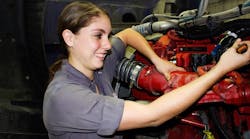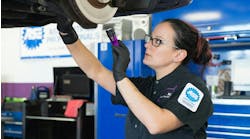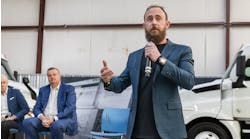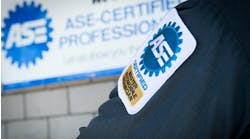How recruiting women can help defeat the tech shortage
This is Part 3 of a 5-part series on the trucking tech shortage and the strategies to combat it. Read Part 1 here. Read Part 2 here.
At Heavy Duty Aftermarket Dialogue in January, John Blodgett, vice president of sales and marketing of MacKay & Company, revealed a survey done by the consulting firm found fleets' top concern going into 2020 was the technician shortage.
He noted the issue "was not new, but is higher in the ranking from where it has been in the past."
Until recently, the industrial trade, like so many others, has only actively recruited men, which comprises a tad less than half the population. Anytime your choices are slashed in half, your quantity and quality are bound to suffer. So while engine complexity, wages, retirements and messaging are critical factors, the most logical area to address the truck tech shortage is where it has been most glaringly deficient: viewing women as viable workers on the shop floor.
“By the industry not looking to hire more women, I think they’re missing out, quite honestly,” said Tyson Sontag, a former TMCSuperTech winner and current high school diesel technology teacher..
In his classroom, which is at most 3 girls to 12 boys (usually less), he noticed some of the advantages women bring to the trade. He observed they were more detail-oriented, kept tidier work stations with parts sequenced, and while not as fast as the boys, their work is right the first time.
These are stereotypes traditionally associated with women, and even if not always true show how they could balance a shop floor. But it’s the negative tropes, such as women not being strong enough to do the job, that seem to keep most shops male-dominated.
Not every man, especially those whose bodies have seen decades of wear and tear, is strong enough to do every task by himself. This is where teamwork comes into play.
“There’s always some young dumb lug trying to prove his strength—let him pull the cylinder head, and let this girl take apart the dash and figure out why something’s not working,” Sontag mused.
It’s not the most politically correct response, but rings true. A woman, whatever her size, might not always be able to lift as much, but can carry just as much of the workload.
About an hour north, TLG Peterbilt-Joplin learned this, thanks to a tech named Aymee Cunningham, a petite woman who often heard customers question her value to the shop since 2011. She recalled how this all changed in 2014 via a YouTube video posted by the business. It started when a concrete pump truck had a check engine light pop on and interrupt pouring operations. No one from the OEM or Cummins could figure it out.
“I decided I was going to make my own circuit for it,” she explained, believing the wiring was too small to consistently handle the current.
“I fixed it,” she said, still visibly affected by the small victory for the shop and giant leap for her self-esteem. “They haven’t had a lick of problems since.”
That one moment was a game-changer for at least that one shop.
“It was an eye-opener for everybody when she solved that,” recalled general manager Roger Bartlett. “It was a big deal and she gained a lot of respect.”
Few women can command respect upon first walking through the garage door. Bonnie Greenwood is one.
While attending WyoTech in Laramie, Wyo., Greenwood became the first female champion of TMCFutureTech, the student version of SuperTech, in 2017.
Greenwood had a college degree (in wildlife biology) but decided she’d rather be a grease monkey. She was hired almost immediately by FedEx Freight in Salt Lake City.
And the term “grease monkey” is somewhat of an anachronism, said Ellen Voie, founder and CEO of Women in Trucking, an advocacy group promoting female representation in the industry.
“People have a misconception when you say diesel tech; they’re thinking that you’re all greasy,” Voie said. Sometimes that is still absolutely true, but you don’t need to be six-foot-five and built like a gorilla.
“These days there’s no reason why women can’t do the job,” she said. “It’s not as physically demanding as it once was.”
But Voie questions if the industry is doing enough to let women know the trade has become more accessible. She also mentioned women’s smaller hands are something of an advantage when working with wiring, and they can get to places many men can’t without removing a ton of other components. It’s not hard to imagine a giant master mechanic sheepishly asking the new female tech to unscrew a sensor deep within the labyrinth of pipes and hoses so he doesn’t have to spend half a day disassembling it.
Perception is still the biggest challenge. Voie alluded to the infamous Snap-On Tool calendars of yesteryear featuring bikini models as a symbolic “no girls allowed” sign.
“It’s always been such a good ol’ boys network,” she said. “It takes time to realize they need to make changes.”
Since 2016, Ryder has supplied 20 women with technical scholarships, up to $2,000 each, to aid in their education. Diesel mechanic school tuition can cost around $5,500 for an 18-month program.
“Ryder is taking the lead in drawing more women to the transportation industry, at a time when the industry needs to grow the pool of qualified diesel technicians and professional drivers,” said Patrick Pendergast, vice president of recruiting services at Ryder.
“Together with the Women In Trucking Foundation, we are able to make technical education more affordable for women who are striving to make a career in trucking a reality,” he continued.
A best practice Roehl Transportation uses is showing trainers the movie North Country, where Charlize Theron’s character must assimilate into a coal mine, and discussing the movie afterwards.
“It sensitizes them to what women are feeling and thinking when they enter a male environment,” Voie said.
Any company wanting to address the issue must go all in, though, and be prepared for the challenges, she said.
To get to that point, Voie believed the way trucking markets these jobs must reverse course. “[Some companies] just have this mindset that they think that a NASCAR car in their ad or a Dallas cheerleader is what people are looking for,” she said. “You just eliminated half the population because that doesn’t attract women.”
And if this is truly as critical a problem as everyone says, and it’s been going on for decades (as we spelled out in Part 1), it’s crazy not to at least try.





